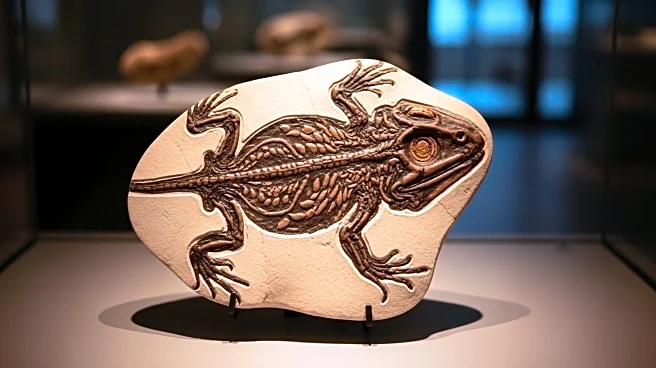What's Happening?
A fossil of Arenaerpeton, a species of ancient amphibian, was discovered in a pile of garden stones on Australia's Central Coast. The fossil, dating back 240 million years, was well-preserved with skin outlines and an almost complete skeleton. Researchers have named it Arenaerpeton supinatus, marking it as a new member of the Gondwanan amphibian family. The fossil provides insight into the Early Triassic period, shortly after Earth's worst mass extinction. Lachlan J. Hart, a PhD candidate at UNSW Sydney, led the research, which was published in a peer-reviewed journal in 2023. The fossil is a unique example of temnospondyls, a group of extinct animals that lived before and during the time of dinosaurs.
Why It's Important?
The discovery of Arenaerpeton supinatus fills a geographic and temporal gap in Australia's fossil record, providing new insights into the diversity of early amphibians. This fossil is significant as it is the first chigutisaurid named from New South Wales, indicating that large-bodied forms were present early in the Triassic. The preservation of soft tissue around the skeleton offers rare details about the animal's physical characteristics and lifestyle. The research highlights the importance of community involvement in scientific discoveries, as the fossil was preserved by a homeowner and later studied by museum staff and researchers.
What's Next?
The study of Arenaerpeton supinatus may lead to further exploration of the Sydney Basin to uncover more fossils from the Early Triassic period. Researchers may continue to analyze the fossil to understand its ecological role and evolutionary history. The findings could prompt additional studies on temnospondyls and their survival strategies across mass extinction events.
Beyond the Headlines
The discovery of Arenaerpeton supinatus underscores the importance of preserving and studying fossils to understand Earth's history. It highlights the role of large body size in the longevity of species across geological time. The fossil also contributes to the broader narrative of recovery after mass extinction, offering a glimpse into the ecosystems that existed during the Early Triassic.












